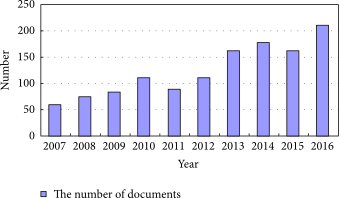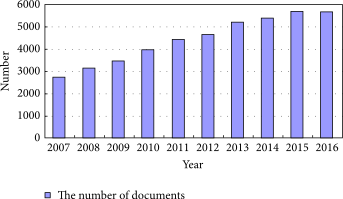Journal:Big data management for cloud-enabled geological information services
| Full article title | Big data management for cloud-enabled geological information services |
|---|---|
| Journal | Scientific Programming |
| Author(s) | Zhu, Yueqin; Tan, Yongjie; Luo, Xiong; He, Zhijie |
| Author affiliation(s) |
China Geological Survey, Ministry of Land and Resources, University of Science and Technology Beijing, Beijing Key Laboratory of Knowledge Engineering for Materials Science |
| Editors | Liu, A. |
| Year published | 2018 |
| Volume and issue | 2018(2018) |
| Page(s) | 1327214 |
| DOI | 10.1155/2018/1327214 |
| ISSN | 1875-919X |
| Distribution license | Creative Commons Attribution 4.0 International |
| Website | https://www.hindawi.com/journals/sp/2018/1327214/ |
| Download | http://downloads.hindawi.com/journals/sp/2018/1327214.pdf (PDF) |
|
|
This article should not be considered complete until this message box has been removed. This is a work in progress. |
Abstract
Cloud computing as a powerful technology of performing massive-scale and complex computing plays an important role in implementing geological information services. In the era of big data, data are being collected at an unprecedented scale. Therefore, to ensure successful data processing and analysis in cloud-enabled geological information services (CEGIS), we must address the challenging and time-demanding task of big data processing. This review starts by elaborating the system architecture and the requirements for big data management. This is followed by the analysis of the application requirements and technical challenges of big data management for CEGIS in China. This review also presents the application development opportunities and technical trends of big data management in CEGIS, including collection and preprocessing, storage and management, analysis and mining, parallel computing-based cloud platforms, and technology applications.
Introduction
In the era of big data, the data-driven modeling method enables us to exploit the potential of massive amounts of geological data easily.[1][2][3] In particular, by mining the data scientifically, one can offer new services that bring higher value to customers. Furthermore, it is now possible to implement the transition from digital geology to intelligent geology by integrating multiple systems in geological research through the use of big data and other technologies.[4]
The application of geological data management in the cloud makes it possible to fully utilize structured and unstructured data, including geology, minerals, geophysics, geochemistry, remote sensing, terrain, topography, vegetation, architecture, hydrology, disasters, and other digital geological data distributed in every place on the surface of the earth.[4][5] Moreover, the geological cloud will enable the integration of data collection, resource integration, data transmission, information extraction, and knowledge mining, which will pave the way for the transition from data to information, from information to knowledge, and from knowledge to wisdom. In addition, it supports data analysis, mining, organization, and management services for the scientific management of land resources, prospecting breakthrough strategic action and social services, while conducting multilevel, multiangle, and multiobjective demonstration applications on geological data for government decision-making, scientific research, and public services.[5]
Big data technologies are bringing unprecedented opportunities and challenges to various application areas, especially to geological information processing.[2][6][7] Under these circumstances, there are some advancements achieved in the development of this area.[8][9] Furthermore, from various disciplines of science and engineering, there has been a growing interest in this research field related to geological data generated in the geological information services (GIS). We analyzed the number of those documents indexed in the “Web of Science” research database.[10] In Figures 1 and 2, we can easily find that, in the past ten years, the number of those documents in which “geological data” is in the title and in the topic is increasing, respectively. Hence, geological data analysis in GIS is an interesting and important research topic currently.
|
|
References
- ↑ Vermeesch, P.; Garzenti, E. (2015). "Making geological sense of ‘Big Data’ in sedimentary provenance analysis". Chemical Geology 409: 20-27. doi:10.1016/j.chemgeo.2015.05.004.
- ↑ Jump up to: 2.0 2.1 Chen, J.; Xiang, J.; Hu, Q. et al. (2016). "Quantitative Geoscience and Geological Big Data Development: A Review". Acta Geologica Sinica 90 (4): 1490–1515. doi:10.1111/1755-6724.12782.
- ↑ Zhu, Y.; Tan, Y.; Li, R. et al. (2016). "Cyber-physical-social-thinking modeling and computing for geological information service system". International Journal of Distributed Sensor Networks 12 (11). doi:10.1177/1550147716666666.
- ↑ Jump up to: 4.0 4.1 Kim, Y.-H.; Yarlagadda, P. (2013). "Cloud Computing Model for Big Geological Data Processing". Applied Mechanics and Materials 475–476: 306-311. doi:10.4028/www.scientific.net/AMM.475-476.306.
- ↑ Jump up to: 5.0 5.1 Chen, J.; Li, J.; Cui, N.; Yu, P. (2015). "The construction and application of geological cloud under the big data background". Geological Bulletin of China 34 (7): 1260–1265. http://caod.oriprobe.com/articles/46629977/The_construction_and_application_of_geological_cloud_under_the_big_dat.htm.
- ↑ Li, C. (2010). [10.1109/GEOINFORMATICS.2010.5567743 "The technical infrastructure of geological survey information grid"]. Proceedings from the 18th International Conference on Geoinformatics 2010: 1–6. 10.1109/GEOINFORMATICS.2010.5567743.
- ↑ Wu, L.; Xue, L.; Li, C. et al. (2015). "A Geospatial Information Grid Framework for Geological Survey". PLoS One 10 (12): e0145312. doi:10.1371/journal.pone.0145312.
- ↑ Evangelidis, K.; Ntouros, K.; Makridis, S.; et al. (2014). "Geospatial services in the Cloud". Computers & Geosciences 63: 116–122. doi:10.1016/j.cageo.2013.10.007.
- ↑ Huang, M.; Liu, A.; Wang, T.; Huang, C. (2017). "Green data gathering under delay differentiated services constraint for internet of things". Wireless Communications and Mobile Computing. https://www.hindawi.com/journals/wcmc/aip/9715428/.
- ↑ "Web of Science". Clarivate Analytics. https://www.webofknowledge.com/.
Notes
This presentation is faithful to the original, with only a few minor changes to presentation. In some cases important information was missing from the references, and that information was added.











